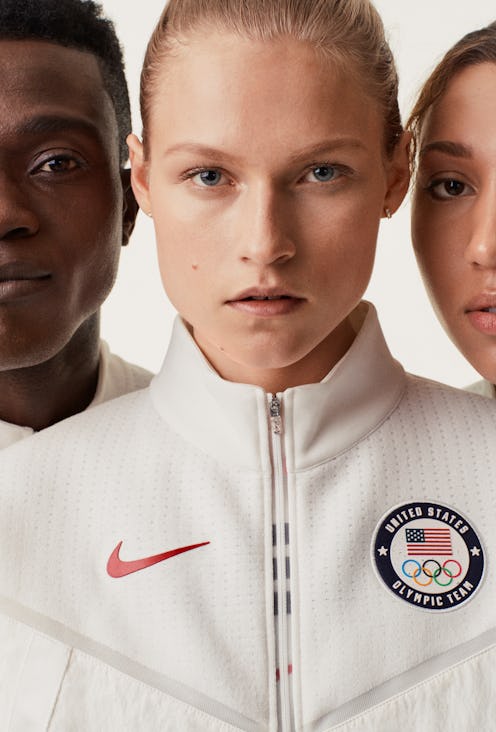(Fashion)
Nike Asks: What Does National Pride Look Like In 2020?

The Olympics are a global demonstration of unity and human potential, a feel-good idea that has become all too real in the face of a climate crisis that demands, well, a delicate multi-national conversation. That urgency is all over the symbolic details of the 2020 Olympic games in Tokyo games, the athletes' uniforms, too. The medals are made from recycled cell phones; the stadium architecture celebrates native plants; even the plushy anime mascot Miraitowa’s name is a portmanteau of “mirai,” meaning “future” and “towa,” meaning “eternity.”
The question for Nike, who for the 32nd year will dress athletes representing the United States on the medal podium, is: What’s team USA’s role in all this? How do you bring global accolades to a country that, since the last Olympic games, has pulled out of an international climate accord and turned away political refugees? What does national pride look like in 2020?
The brand's answer, judging from the Feb. 5 release of Team USA’s Tokyo Olympics looks — for the medal stand, along with track & field, soccer, basketball, and for the first time, skateboarding — is an ambitiously sustainable pack of products that uses innovative materials, minimizes waste production, and celebrates America’s history of sport.
The medal stand tracksuits tone down the stars and stripes for a mostly white look that resembles what an American astronaut might wear on an international space mission. The letters USA on the underside of the jacket’s right forearm, appear when the medalist places their hand over their heart for the national anthem — a favorite detail among those competing. "The Olympics is not a time to be shy," explains John Hoke III, Nike's Chief Design Officer, as we sit in a stark all-white room, looking for the first time at what will be Team USA's kit come summer. "It's a moment of dreaming big, working with athletes' wildest audacious imagination and abilities, taking daring steps forward. And most importantly, taking actions, converting words and concepts into real life products that push performance forward."
According to Hoke, the Olympics are an opportunity to act on the brand’s innovative reputation and set new standards for sustainable materials, since athlete performance cannot be compromised. “You can't make a product that is sustainable but doesn't live to the standard of excellence that our athletes want. So I think we're in the ability of literally developing new material science."
For the 2020 games, team USA's medal stand suit is constructed out of 100 percent recycled polyester and the logo is stamped with recycled rubber. The sneakers, the Air Vapormax 2020, are made of 75 percent manufacturing waste. This spring Nike is also releasing a four-style futuristic footwear collection called Space Hippie constructed of scrap from Nike's factory floors repurposed into yarn or ground into flecks and embedded in the shoes' foam, a design concept which inspired the futuristic podium looks. The final ensemble looks contemporary, yet wouldn’t have been out of place in Stanley Kubrick's “2001: A Space Odyssey.”
Back on earth, the 2020 Olympic marathon has been relocated due to concerns about the heat. Going into what's reported to be the hottest games on record, athletes' health has been a priority through the design process. "As Paralympic athletes, we have a hard time regulating temperature, explains Tatyana McFadden, a 17-time medalist in track & field. "It doesn't matter how good you are compared to the rest of the world if you can't make it because of the heat." She explains that the more streamlined and breathable a uniform is, the better. But, she notes that this year, the dual focus on sustainability is a particular point of pride. "The saying is that if there's no planet, there's no sports," she explains. "It's good to know that we're wearing something that's environmentally friendly and it looks good too."
"We believe that we play a role in protecting the future of sports. Sport is a birthright for every generation." — John Hoke III
The Nike designs pair futuristic materials with nostalgic references: the years of the women's' basketball teams' gold medals are hidden in a flap on the shorts; the away soccer jerseys feature an abstract, blue-on-blue camo; and the new skateboarding tops are inspired by basketball jerseys, a nod to the NBA and WNBA’s popularity stateside.
"Regardless of nationality, when you watch the Olympics, you're watching the human race really come together," Hoke says. "We're thinking about cultural appreciations, not just nationalistic pride. So we're going several clicks deeper, even providing little Easter eggs of information that connect back to the story. The job is not to alienate. The job is to unite everyone in the awe of sports."
There’s hard sales data to support the notion that American athletes can unite us, perhaps especially when their achievements are symbolic of the off-field challenges we face. After team USA won the women’s world cup amid a public battle for equal pay, their top became Nike's best selling jersey of all time.
This article was originally published on